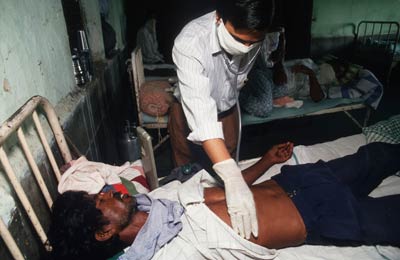
A plague hit the city of Surat in Gujarat in September 1994. The government officials soon declared an international public health emergency and reported it as a pneumonic plague epidemic. Needless to say, this resulted in widespread panic-both in India and abroad. Though the plague was largely pneumonic, the bubonic form was found in three Maharashtran villages before the outbreak in Surat.
Fleeing people
An excerpt from the newspaper ‘The Hindu Universe’ dated 25 September 1994 reads thus: “The people fleeing the affected zones are heading in all directions and taking the hysteria with them. With the discovery of three people afflicted with plague in a Bombay hospital, panic has gripped that city as well. Tetracycline, an antibiotic for plague treatment, has disappeared from chemist shops not only Bombay but also in Delhi”.
It was rumored that Surat would be quarantined. But when that got delayed, abound a fourth of the city’s population( 4 to 6 lakh) fled within four days since the epidemic was announced. Among those who fled were those still in the incubation phase of the infection.
Thanks to panic buying of medicines, broad-spectrum antibiotics needed to prevent the disease were exhausted. At other Indian cities, checkpoints were put up at airports and railway stations to monitor incoming Surat inhabitants. They would be received by medical teams and then quarantined.
In many of Surat’s neighboring cities, hospitals were alerted about the possible arrival of plague-infected people. The exodus, in fact has to be forcibly stemmed with the aid of paramilitary forces so that the disease could be prevented from spreading.
Thanks to the fact that the disease got diagnosed and suppressed fast, the outbreak didn’t have as devastating a result as originally feared. But the anxiety levels were high across the world and so was the economic toll on the country. Since the outbreak happened just before Diwali, in Surat alone the total loss to business was more than $260 million.
A plague of misinformation
The incident’s impact was felt in other major Indian cities including Mumbai and Delhi.
In New Delhi, for instance, since there was a lack of public information on how to deal with the disease, people brought surgical masks and tetracycline in large numbers. Educational institutions and public entertainment spaces were ordered to be closed as a precaution. Even states like Orissa- thousands of kilometers from Surat began to take steps to check the outbreak.
In Rajastan, villagers initiated drives to kill rats.
Back in Surat, authorities ordered the closure of educational institutions, cinemas, banks, offices etc. for an indefinite period. By this point, the plague has been in Surat for almost two weeks.
Not much was given to the public in the way of proper instructions for preventive measures.
To make matters worse, there was misinformation too. Daily statistics on suspected plague cases added to this. In fact, the officials declared a plague epidemic even before it was verified that the plague was pneumonic. Neither did the Union Health Ministry issue any statements clarifying the scenario. Many regional newspapers, it’s said, reported an exaggerated death count.
Those who suffered from a normal fever from the plague area were considered as plague cases. Over 6,000 reported plague causes were, in fact from other diseases.
However, to the government’s credit, the spread of the plague was successfully curbed soon after.
Once the plague cases were identified, antibiotics were provided to nearly everyone in the neighbourhood. Other measures like clearing the port areas of rats, fumigation of cargo and dusting of insecticides to kill rat fleas all helped control the disease’ spread.
Silver lining
Thanks to the Surat plague, the nation took multiple steps to prepare for such incidents in the future. Also, medical school courses were revised to include plague in more depth. The plague research unit of the National Institute for Communicable Diseases was modernized so that diagnosis can be made easier.
Aside from activating plague control units across the nation, the central government also decided to install a much more sophisticated national surveillance system.
Thanks to such measures, the more recent plague outbreak in Himachal Pradesh in 2002 was effectively and quickly contained.
Image credits: science.howstuffworks.com
Images may be indicative